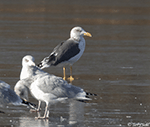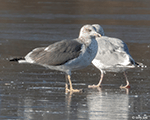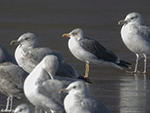| Length: 22 inches | Wingspan: 54 inches | Seasonality: Rare Visitor |
| ID Keys: Dark gray back and wings, yellow legs, yellow bill with red spot. | ||
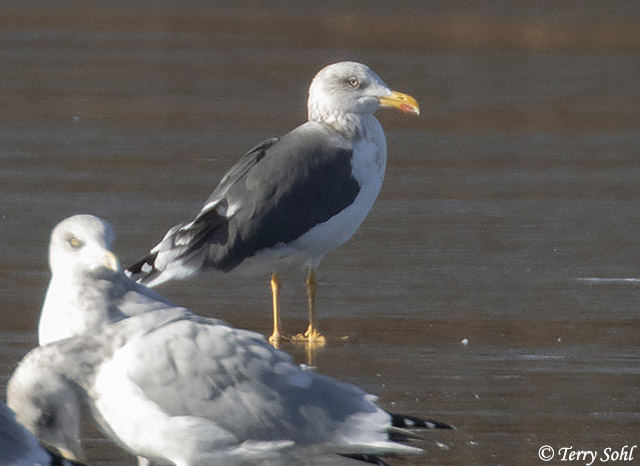 The
Lesser Black-backed Gull is normally a Eurasian gull, but has been seen with
increasing frequency in North America in recent decades. This is likely
due to the establishment of the species as a breeding bird in Iceland in the
1920s, and explosion of the population there in the decades since. Lesser
Black-backed Gulls have also now begun breeding in Greenland, and sightings
continue to increase in North America. As numbers continue to
increase, it's quite possible that the Lesser Black-backed Gull may one day
begin breeding in North America.
The
Lesser Black-backed Gull is normally a Eurasian gull, but has been seen with
increasing frequency in North America in recent decades. This is likely
due to the establishment of the species as a breeding bird in Iceland in the
1920s, and explosion of the population there in the decades since. Lesser
Black-backed Gulls have also now begun breeding in Greenland, and sightings
continue to increase in North America. As numbers continue to
increase, it's quite possible that the Lesser Black-backed Gull may one day
begin breeding in North America.
In South Dakota, a dark-backed gull is most likely to be a Lesser Black-backed Gull. Sightings were very rare, but they are now seen in very small numbers nearly every year.
Habitat:
Primarily found along coastlines, but also occasionally around inland lakes (especially the Great Lakes).
Diet:
Omnivorous. Feeds on fish, crustaceans, mollusks, insects, worms, eggs, small birds, small rodents, amphibians, carrion, refuse, berries, and other plant material.
Behavior:
Will forage by walking on land, wading in shallow water, dipping down to the water's surface while in flight, or by swimming.
Breeding:
Non-breeder in South Dakota. They have yet to regularly breed in North America, although single nesting attempts have increasingly occurred. They are colonial nesters, with nests constructed on the ground in sheltered coastal locations or on cliffs. The nest itself is a mound of vegetation, typically seaweed for birds nesting along the coast, or grasses and other vegetative material if that's available. A shallow depression at the top of the mound houses the eggs, with the female laying between 2 and 4 light brownish or olive-colored eggs. Incubation lasts 25-28 days with both parents helping to incubate the eggs.
Song:
Lesser Black-backed Gulls have a wide range of calls reminiscent of other Larus gull species.
- Click here to hear the calls of a single Lesser Black-backed Gull perched on the ground1
- Click here to hear the rapid alarm calls of a single Lesser Black-backed Gull2
- Click here to hear a laughing-like call of a Lesser Black-backed Gull3
Migration:
Normally a European Gull, stragglers have been seen throughout the United States in nearly any month. Most sightings in South Dakota are in the fall or spring months when migration of other gull species is underway.
Interactive eBird Map:
Click here to access an interactive eBird map of Lesser Black-backed Gull sightings
Similar Species:
Within the borders of South Dakota, Lesser Black-backed Gulls are most similar to the Great Black-backed Gull and the Herring Gull. Great Black-backed Gulls are an extreme rarity in South Dakota with just a handful of records. Size differentiates those two species, as Lesser Black-backed Gulls are a relatively small gull compared to both of the other gulls on this list. Great Black-backed Gulls also have an even darker mantle color than the Lesser Black-backed Gull, and have pink legs, not yellow.
Herring Gulls are a much more common sight in South Dakota than either of the other two species. They do have a somewhat darker mantle color than the ubiquitous Ring-billed Gull (the most common gull in the state), but it's not as dark as that of a Lesser Black-backed Gull. Herring Gulls also have pink legs, not yellow like a Lesser Black-backed Gull.
For clues to differentiating these and other "Larus" gull species, see Identification Tips. Note that outside of South Dakota, the Lesser Black-backed Gull is also very similar to the Yellow-legged Gull and the Kelp Gull, both rare visitors to North America.
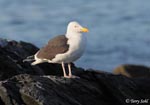 |
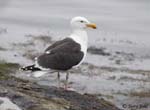 |
 |
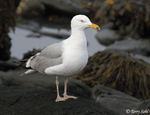 |
| Great Black-backed Gull | Great Black-backed Gull | Herring Gull | Herring Gull |
Conservation Status:
Systematic surveys in North America indicate increases in overall populations in recent decades, and range seems to be expanding as well. Sightings are increasingly frequent in many parts of North America, including South Dakota. Lesser Black-backed Gulls are found across a broad geographic area, they are common in parts of that range, and the overall population is strong. The IUCN considers the Lesser Black-backed Gull to be a species of "Least Concern"..
South Dakota "Hotspot":
Lesser Black-backed Gulls are considered a rarity in the state, but there are indications sightings may be on the increase. Easily the best places to look for a Lesser Black-backed Gull are around the dams on the Missouri River, in the fall and winter months when they provide some of the only open water available in the state.
Further Information:
- USGS Patuxent Bird Identification InfoCenter, Lesser Black-backed Gull
- WhatBird - Lesser Black-backed Gull
- Audubon Guide - Lesser Black-backed Gull
Photo Information:
November 17th, 2019 -- Below Oahe Dam near Pierre, South Dakota - Terry Sohl
Audio File Credits:
- 1Jack Berteau. Recorded in Pays de la Loire, France on June 9th, 2019. Original recording and information available on xeno-canto.
- 2Stanislas Wroza. Recorded near Reykjavik, Iceland on August 17th, 2018 . Original recording and information available on xeno-canto.
- 3Stanislas Wroza. Recorded on the coast of France on May 12th, 2019 . Original recording and information available on xeno-canto.
| Click on the map below for a higher-resolution view |
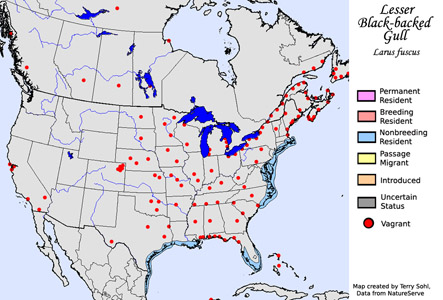 |
| South Dakota Status: Rare visitor, most often found along the Missouri River and near Missouri River dams. |
Additional Lesser Black-backed Gull Photos
